Dear customer!
This thread is devoted to answer all your questions about the McLuxIII Series of McGizmo lights. It will be updated frequently as soon as new information is available, so make sure to check back often.
__________________________________________________
The McLuxIII-PD
__________________________________________________
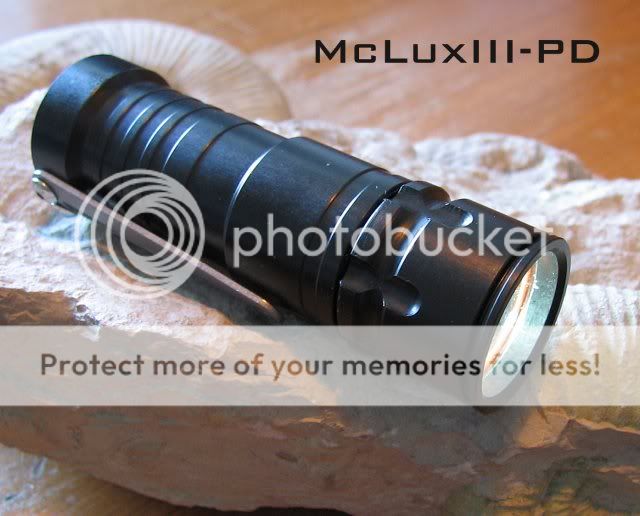
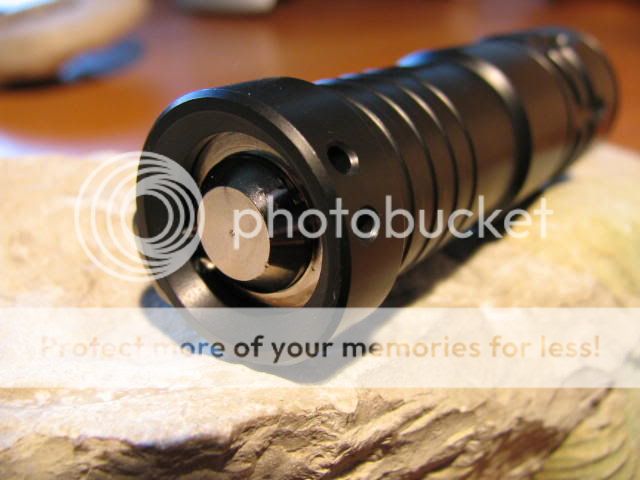
What is the McLuxIII-PD
The McLuxIII-PD is the third generation of the McLux lights made by McGizmo. As opposed to the McLux-Aleph Series, this light is basically a stand-alone light without a modular approach. This means it isn't SF E-Series compatible, won't mix with Aleph parts and is ready to go when you receive it.
"PD" stands for "piston drive" and describes the new revolutionary mechanics of the switch incorporated in the light.
Please tell me more about the construction of the light!
Here's a pic showing the McLuxIII with various parts exposed:
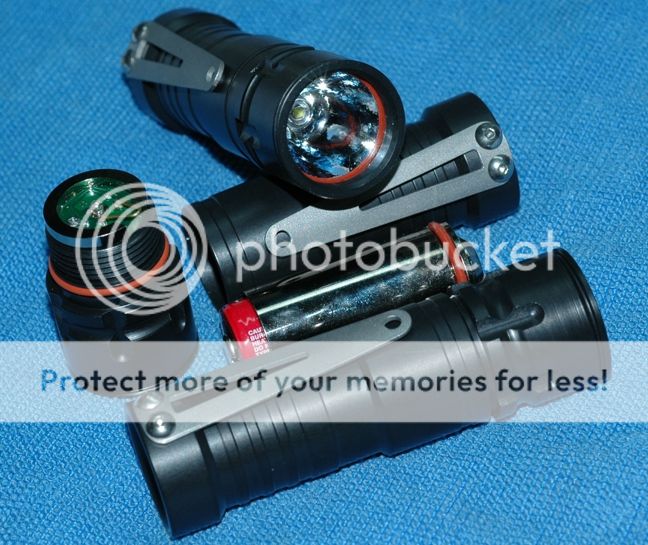
… and here's the schematics:
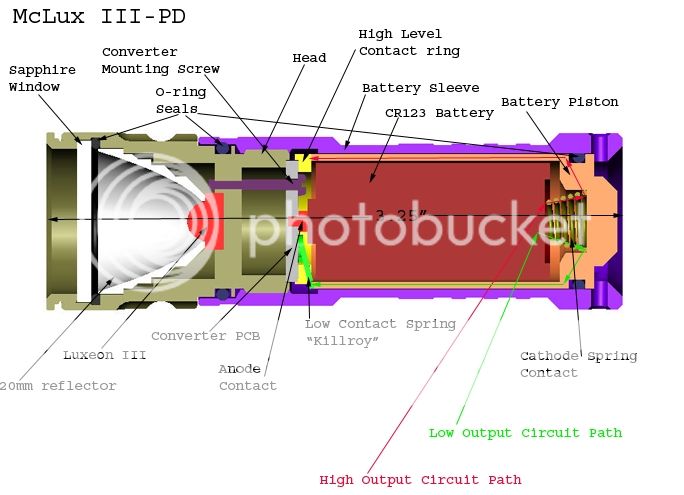
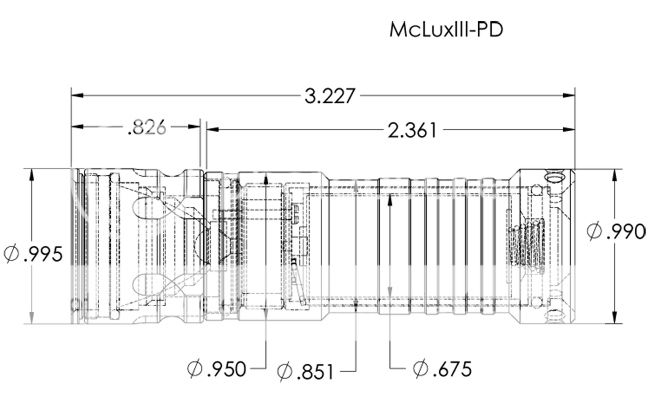
The head is a return to the good old days of the first McLux lights and is an integral bulkhead design for optimum heat management. The LED rides directly on the metal of the head instead of using a threaded LE or other methods of interaction.
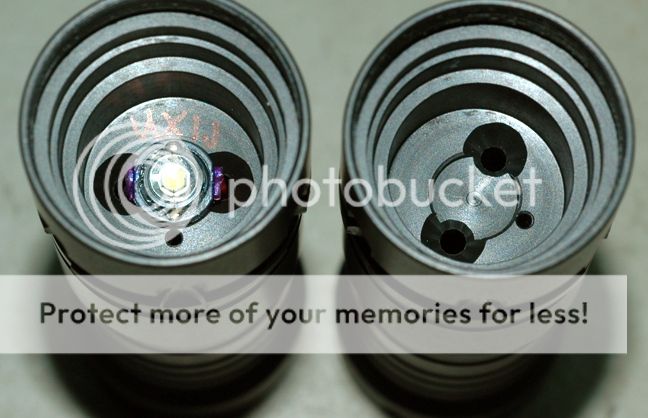
On the business end you are looking at a sapphire window that has AR-coating on the inside for optimum light-transmission and toughness. It is held in place by a new version of the bezel ring with a bigger lip for optimum impact protection as well as a further improved water seal at the front end. The front end of the PD is identical in thread and window seating to the Aleph 2 and one could use the Aleph 2 bezel ring instead of the one currently supplied. There is a reason for going with a ring that adds about .062" to the length of the light and that is strength. This bezel is significantly stiffer and stronger than the notched A-2 ring.
The battery tube is fairly straight forward and offers an attached Ti-clip as well as 2 small holes for lanyard attachment. Of course the switch is recessed to allow tailstand.
A true piece of art is the switching-mechanism … the piston-drive!
The piston is an electrically conductive sleeve that houses the battery riding on a contact spring. The environmental seal is achieved by an o-ring riding at the lower part of the piston making contact with the inner wall of the body. The piston is exposed at the rear end of the light (see pic above) and serves as momentary switch. The cool thing about this very complicated and innovative switching method is that it allows for a fully regulated 2-stage switching at the driver board location with the perfect electrical path (see diagram) in a completely anodised light body for maximum protection from harm while retaining the perfect seal from the environment. There is no electrical path through either the body or the head and both are completely anodized with no breaks in the plating.
thing about this very complicated and innovative switching method is that it allows for a fully regulated 2-stage switching at the driver board location with the perfect electrical path (see diagram) in a completely anodised light body for maximum protection from harm while retaining the perfect seal from the environment. There is no electrical path through either the body or the head and both are completely anodized with no breaks in the plating.
There are two copper plated vias that go through the PCB and kilroy's legs go into these vias and are solder filled. Kilroy's nose is deflected about .030" in total as the lip of the piston first contacts kilroy for low level and then proceeds to bottom out on the perimeter contact ring for high output. This amount of deflection distributed over the length of kilroy seems to be well short of deformation. Since the beryllium copper is a material of choice in contact springs, we can only assume that there will be no issues of fatigue in this application. As to the integrity of kilroy's mount, I don't believe the solid footing through the PCB vias will be stressed by the load subjected to kilroy's nose in this application.
The full stroke of the piston is typically less than probably .060" (1.5 mm).
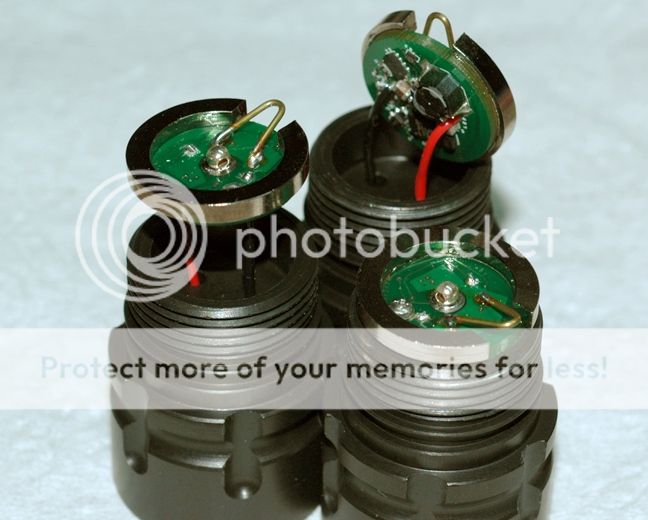
Note that there isn't any knurling on this light … yet it is still grippy to boot! The head has milled flutes to allow easy twist-operation and the body has grooves, the clip and the rear shroud for stability. No abrasion on your precious pants any more !
The o-ring dimensions are:
Piston : #016
Head : #017
Window : #019
What are the materials used?
Only the best for our customers :nana:
The light is CNC-machined from aircraft aluminium and TypeIII hard anodised in "dark slate grey", the color already familiar from the Aleph-Series. The clip is titanium, the window Sapphire Crystal with nice stress relieved and ground edges with AR-coating on the inside. For the piston we used brass with a nickel-plating for optimum conductivity. To ensure reliable and durable function, the kilroy is made of silver plated beryllium copper. The contact spring is also silver plated as well as the nickel plated brass contact. All wires are tinned copper and jacketed in tefflon. There is no aluminium anywhere in their path and both the head and sleeve of the McLuxIII-PD are completely anodized and outside of any electrical paths. Last but not least, the o-rings are EPDM.
What about the lens and possible replacements?
The lens is sapphire crystal with an internal AR coating ... extremely hard but sacrifices some output in the process. 4sevens has taken some "unofficial" measurements:
Lux at 1 meter:
1387 no lens
1229 (88.6%) stock sapphire AR inside
1222 (88.1%) stock sapphire AR outside
1371 (98.8%) water-white glass double side AR for arc4+ from flashtlightlens.com
The choice in this light is for maximum strength and durability of the lens with good light transmission, but there are other options. It is all a matter of choice between strength, transmission and possibly fragile outside coatings.
It seems that the lenses for the PD, Aleph2, Arc4 and HDE EDC are interchangeable ... and it seems that the PD's bezel ring will fit the other lights, too. But please be aware that you are on your own should you try anything foolish with those fine lights!
Which reflector does it use?
The light uses the venerable McR-20 which is well known of the Aleph-Series. More about this marvel can be read in the Aleph-FAQ in the same forum.
Basically you get three things with that reflector:
- the most perfect beam I have ever seen in a light
- a medium-flood type beam with a relatively big hotspot
- a very strong and concentrated corona that allows for a very useful low-mode

Here is an outdoor beamshot in comparison with some other well-known lights to show the beam characteristics of the McR-20 reflector. The pics are directly comparable due to fixed camera settings. Please note that those lights have different drive currents and aren't meant to compete with the McLuxIII here, this should be informative and allow you tro judge for yourself wether the McLuxIII suits your needs or not. It is not a competition.
McLuxIII-PD (UX1K)

SF KL3 gen2

SF L4

Fenix L1P

SF A2

What are the attachment options?
You have a Ti-clip and two lanyard-holes as well as a slim and small form-factor for easy holster-carry. The 15 mm "pico" clip will also attach to one of these holes and does not capsize.
There is now also the famous tab carry-option. With the McLuxIII-PD the tab is screwed on the clip whith the clip being still fully functional:

You must request that option when ordering.
The Tritium Option
Upon request Don can install a single tritium vial in the tail end of the light directly in the button of the piston:
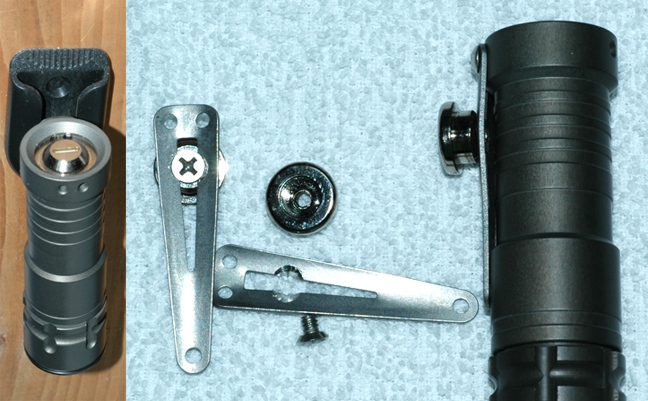
Look at the left pic. Pricing is according to the "ordering thread" $25 and $10 for the clip mount.
The New Clip Option
Upon ordering you can specify that you'd like a new iteration of the Ti-Clip looking like this:
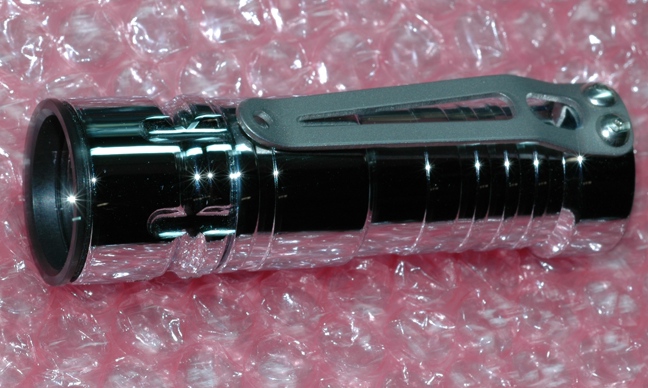
... instead of the standard clip. See the "Ordering" sticky for payment details.
Titanium Bezel Rings
As a limited offer Don created those ...
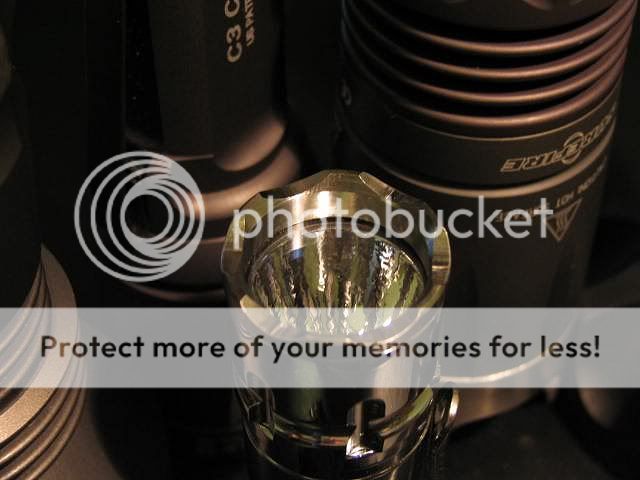
... that will also for your ALeph2, Aleph19, Arc4 and HDS EDC.
The McLuxIII-T
The McLuxIII-T is a titanium variant of the McLuxIII-PD:
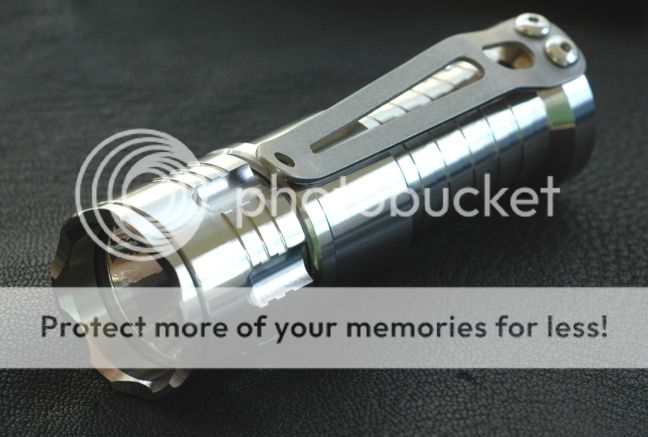
It does not have a piston-drive activation and therefor a twist-only switch with the same 2-stage as the PD using a rev8 Wiz2x2. The LED is a TY0H driven at 525/20mA. It sports the upgraded bead-blasted clip and the new ti-bezel as well as ti-screws to attach the clip.
The TY0H is a "Joker" LED and coupled with the standard McR-20 you will get a more diffused beam with a stronger corona, bigger spot and less throw (=lux readings). It can be fitted with a McR-20J to accomodate the Joker LuxIII and get a standard MrR-20 beam if you are so inclined.
As opposed to the McLuxIII-PD the T uses a removable aluminium heatsink seated with Arctic Ceramic to allow an easy upgrade to newer LEDs:
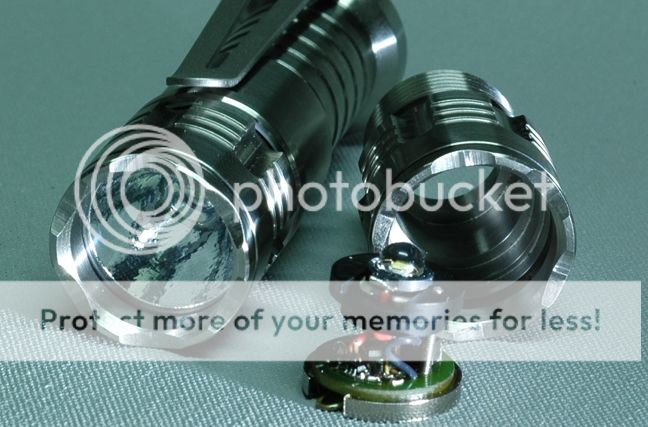
This light is not compatible with the McLuxIII-PD, but the T-head will work on the PD-body, not vice versa.
No custom requests are accepted for this light.
The McLuxIII-Ti-PD
The McLuxIII-PD-Ti is basically a titanium version of the McLuxIII-PD and looks like this:

(picture taken by WAVE_PARTICLE)
Apart from the obvious little design alterations there are some differences worthy to be mentioned:
The Ti-PD uses the new GDx2 driver by dat2zip, a few words about this new driver can be read in Appendix #3 of this FAQ. It comes with the new clip, a titanium bezel and a tritium marker in the piston as well as titanium screws to hold the clip. The spring in the piston is a bit more recessed than in the standard PD to allow for a momentary activation that requires less force than before.
Just like the McLuxIII-T the LED is mounted on a removable aluminium heatsink for a better heat management and possible future upgrades of LED and driver.
The drive levels are about the same as those of the stadnard McLuxIII-PD. There was a list of possible bins to choose from upon order, so no standard LED configuration can be listed.
Can you show me a size-comparison?
Yepp, sure. Here is a pic comparing the McLuxIII-PD with some classics:
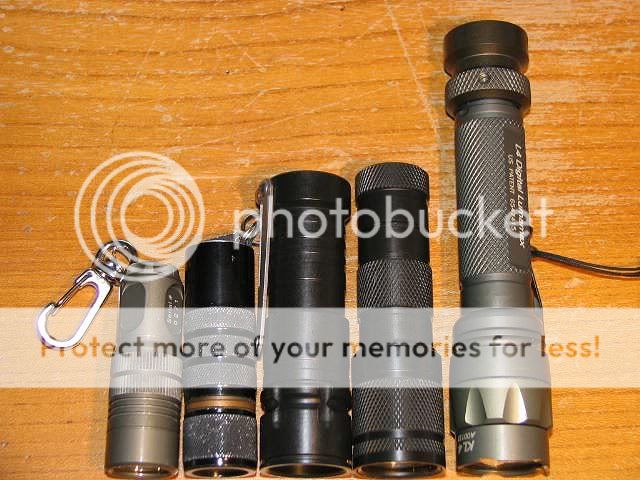
JIL rev1.3 // FireFlyI // McLuxIII-PD // Aleph2 1x123 // SF L4 with Standard Aleph Tailcap
And here's the McLux-Evolution:
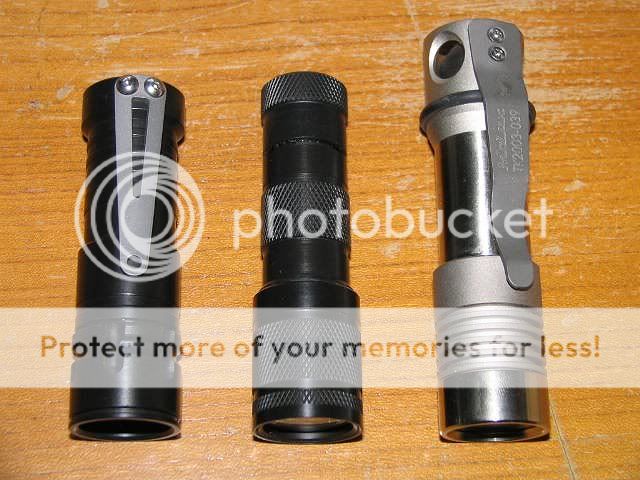
McLuxIII-PD // McLux-Aleph2 1x123 with FT-Tailcap // McLux-TK
Yeah, nice … but how does it work?
This is the easiest part . The McLuxIII-PD follows the KISS-principle (keep it super simple). For constant-on you rotate the head and you will first get low mode and then high mode. All this is done in roughly 30-35% of a turn. For momentary-on you press the silver bottom of the piston at the end of the light for low-mode … and press deeper for high. To replace the battery, screw off the head and pop it out. That's all, it's that simple.
. The McLuxIII-PD follows the KISS-principle (keep it super simple). For constant-on you rotate the head and you will first get low mode and then high mode. All this is done in roughly 30-35% of a turn. For momentary-on you press the silver bottom of the piston at the end of the light for low-mode … and press deeper for high. To replace the battery, screw off the head and pop it out. That's all, it's that simple.
The really good part is that in this light the head rotates and not the tailcap which means you can grab it with you hand and use your thumb and index finger to conveniently dial through the constant-on modes as opposed to the sometimes difficult one-handed action in previous lights. Coupled with the nice milled flutes at the head, the ease of use of this light is astonishing. You don't "need" a tactical grip, you can just hold it in your hand like your old Eveready flashlight of the Ages and turn instead of button-pressing. Just like in the old days …
The action of the piston is a smooth one, and the tension of the momentary-on is roughly the same as with the standard McE2S module of the Aleph-Series. If you are not familiar with this one … buy it, too
 … you should have done that a long time ago.
… you should have done that a long time ago.
Please note that there isn't any lockout mode with this light.
You can unscrew the head further to ensure a highly unlikely accidental activation though. The non-soft spring together with the tail flare should take of the problem efficiently then.
Can the switch configured as "hair-trigger"?
You will find that you can "tweek" kilroy's nose to be as close to hair trigger or far (within reason) as you might like.
Please note that if you do mess with the kilroy spring and end up setting it below the plane of the contact ring such that kilroy does not contact the piston lip, the light will not light up!! If kilroy does not make contact, light won't come on! We have confidence that kilroy will last indefinitely given the displacement of the spring in regular use. It shall not be wise to be bending it back and forth to a great extent playing with adjustment constantly. Certainly time and abuse will tell....
Is it watertight?
Although not conceived as a dive-light, the McLuxIII-PD was able to withstand 120' in a pressure tank in a dive-shop without flooding oo: … and the test was terminated because of lack of time, not because the light eventually flooded. Thanx to MrTedBear for this test!
oo: … and the test was terminated because of lack of time, not because the light eventually flooded. Thanx to MrTedBear for this test!
What's the configuration of the light?
The McLuxIII-PD sports a LuxeonIII-type LED driven by the new Wiz2x2 driver that allow for a regulated high and low mode. It uses a CR123 primary cell or any Li-Ion of similar size that does not exceed 6V. The high mode is set at 580mA and the low mode at 30mA.
Why 580/30mA?
Because after extensive beta-testing in our production plant it seems that those numbers are the best compromise between runtime, brightness, heat and actual usefulness. Yes, usefulness. This light is foremost a tool and thus isn't intended to be a pocket rocket of any kind to impress your mom. At 580mA it is plenty bright for virtually anything you'd want to do with a light this size and runs reasonably cool and long. At 30mA it is surprisingly bright for this little current-flow and boasts a most impressive runtime.
For those of you who always want more light at the expense of anything else :devil: … go for a custom configuration. But be warned that the actual usefulness might be diminished.
that the actual usefulness might be diminished.
The drive current is set via sense resistors on the driver board. BTW, these resistors can be exchanged without any circuit disconect in a completed PD.
So … after all this talk … show me the runtimes!
Sure! Here you go:
The 500mA setting:
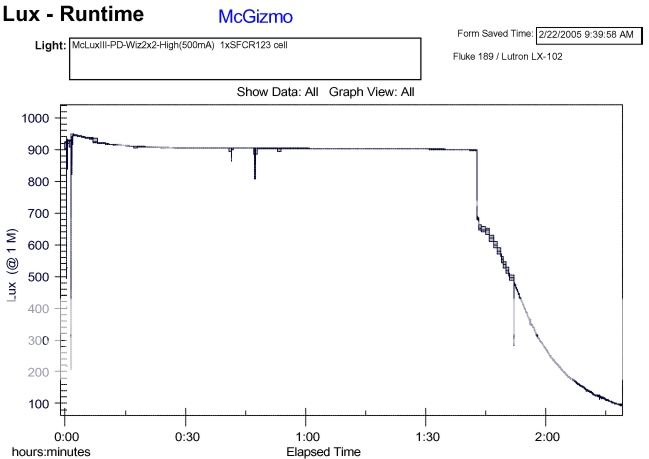
And an example of a 700mA drive level as well as the 30mA low-mode:
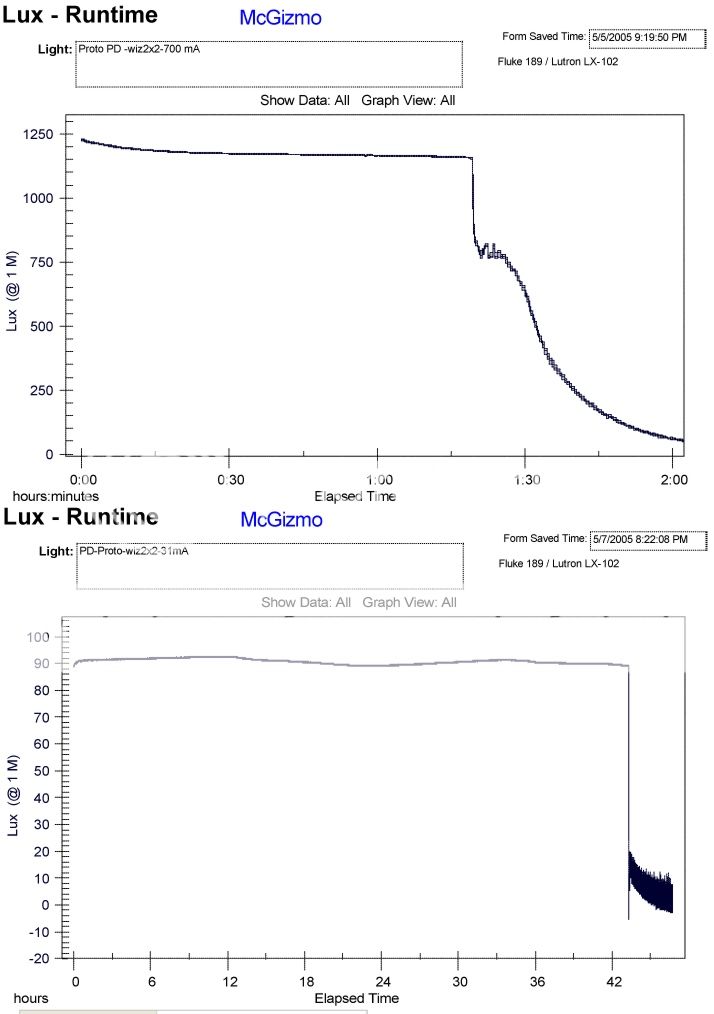
Li-Ions:
wptski got the following results:
MP123 cell stayed around 1580 lux for 1:15 than nosedived
AW LCR123, Lux and runtime the same but no pulsing like the MP123 cells
Please note that your individual runtime will depend on the Vf-bin of your specific Luxeon LED. It is also interesting to note that the runtime on the low-level is roughly doubled when compared to the resistored McE2S of the Aleph-Series.
What about that new Wiz2x2 driver?
This one is a new development of Wayne Yamaguchi (dat2zip) and is a buck/boost driver with a fully current regulated high and low mode. Input voltage is 2.5-6V and output voltage <6V. This means that you cannot use a LuxV :mecry:, but this also implies that it is perfectly ok to run the light with any Li-Ion that meets the size-criteria of a 123-cell.
As an additional bonus the driver has a cut-off voltage of 2.5V, so the use of unprotected Li-Ions is possible.
Because it is a buck/boost, the PD could host a red, R/O or Amber Luxeon as well and the set drive levels on the converter would be what the LED would get. Provided the target Vf of the LED does not exceed 6 volts, this driver will deliver!
As with the Wiz2 driver, this unit has a very high efficiency-rating and is certainly among the very best drivers nowadays in those regards.
For further discussion of this driver as well as the NG2x2 please have a look at the Sandwhich Shoppe and McGizmo forum as this would be too much for this FAQ.
Btw … this marvel is the first current regulated buck/boost that has regulated high AND low mode ever made to the best of our knowledge. Wayne … :thumbsup: :bow:
Note: upon depletion of your battery (approaching 2.5V) you might encounter "flickering" of the light. According to Wayne this is the "flatulent low battery indicator"
"The IC was designed for Li-ion batteries and as such will shutdown at a safe level. An fortunate/unfortunate effect is when the voltage is right at the shutoff voltage after shutting off, the battery recovers enough that it turns back on and then pulses driving the battery down again and the converter shuts down. "
To avoid questions about those yet-to-be-known drivers you can read a good statement by Don about the Wiz2x2 vs. the Ng2x2 in the appendix of this post.
Q: What about the tint of the low-mode?
The low-mode is current regulated which has a lot of advantages over PWM ... except tint. The tint of your LED will shift slightly to the warmer side of the spectrum ... meaning if you really cannot stand a warmer / slightly greenish tint you can significantly reduce the risk of such an issue in the low-mode by selecting a colder tint from the beginning.
Can I have a customised version?
Not right now, but in the near future Don will be open for custom orders following a certain yet-to-be-defined format within reasonable limits. This will most likely include variations of drive currents as well as the NGx2 driver. Stay tuned!
Please note that requests for special one-of-a-kind custom mods and jobs cannot be accomodated and will be turned down. We are sorry for this strict policy, but unfortunately Don hasn't succeeded in growing two additional arms yet :sick2: ...
Tritium custom jobs ... not now, sorry guys .
.
Are there any other finishes or build-options? What isn't possible?
A McLuxIII-PD in HA-NAT has also been released with the bezel ring being black which means you can "instant anodise" dings resulting from drops with a sharpie pen. If you are lucky you might be able to snatch one of the elusive chrome over nickel PDs ...
You can request a bare aluminium light and your request will most likely be accomodated.
There are currently no plans for tritium vials in production lights and no plans for different battery tubes like 2xAA or twisty packs.
Also … forget about the LuxV :mecry:
For the time being, the Wiz2x2 shall be the only driver option, although there might be a NGx2 version on the horizon in the distant future.
What about maintenance?
As every tool, this light needs some maintenance. But not much. Just keep the o-rings lubed (especially when rough conditions or underwater-use are anticipated) and you're ok. If necessary you can disassamble the light and push out the piston via the top end of the body to clean your light. A dry o-ring on the piston might result in friction and resistance with the momentary switch. However, Don has used a prototype for 6 months now without any need to re-lube it.
Replacement parts can be ordered should the need arise. This might become true for the bezel ring after some heavy falls … and because of the construction of this part with the protruding lip it should take most of the hits and after replacement your light will look as good as new again.
How do I order one? And what does it cost?
Visit the McGizmo ordering&pricing sticky thread in this forum and follow the procedures there. It is that simple. The price of your light will depend on the LED being used.
Are there any kits offeres for DIY?
No. This is a turnkey light and comes fully operational to your door … assambled, lubed and with a battery.
Evolution of the McLuxIII-PD
After some time has passed Don implemented some minor improvements into the design:
"Lately I have been deforming (reforming) Kilroy's nose and shortening the battery spring to make the light smoother and easier to activate. These mods have been mentioned in the past but I have been taking the liberty to do them from the start. With the Krytox, stiction doesn't seem to increase over time so I am more comfortable with reducing the battery spring force. When I first started building the PD's I was using silicone grease and stiction was an issue. With a pug nose, Kilroy has more character and can't get his nose in the threads as easily."
You can do this yourself to improve your existing PD:
" In regards to the spring, I have found removing the small dead loop as well as about 1/2 revolution of live coil from the narrow end of the spring works well. You need two small pairs of pliers to bend the new tail down and away from contacting or trying to gauge the battery. If you find you have cut more spring off than you wanted to, you can stretch the spring and deform it to a longer length.
As to Kilroy, If you have an old or cheap set of needle nose or ring pliers, you can blunt or lop off the ends to the desired thickness at the tip and then make sure the jaw that is internal to Kilroy is radiused to allow for a reasonable movement towards the nose tip. You want to close the pliers with the outside jaw pushing kilroy's nose inwards and the inside jaw flairing his nose apart. Look at crude illustration below:
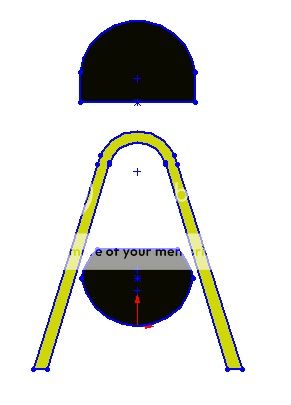
The black forms represent the cross sections of the pliers at the tips. As these are forced together I believe you can imagine the resulting reformation of Kilroy. Lop of the ends of the needle nose pliers until you get the desired cross section in the pliers tips. Do not cut off Kilroy's tip though."
New LEDs and drivers
In the advent of the new generation of power LEDs the McLuxIII-PD will use the Seoul P4 LED offering more light with less heat in a very similar beam pattern. The driver is the newer GDx2 driver.
With the now way brighter and more efficeint LEDs public demand created a "Mizer" option for the PD which has a high level current of 300mA instead of 525mA ... and increases runtime greatly while maintaining the brightness of the older U-bin LuxIII PDs (approximately).
Here's an animated gif illustrating the difference between the PD-S and PD-S Mizer ... done by PoliceScannerMan and animated by jch79, as usual. Thanx guys .
.
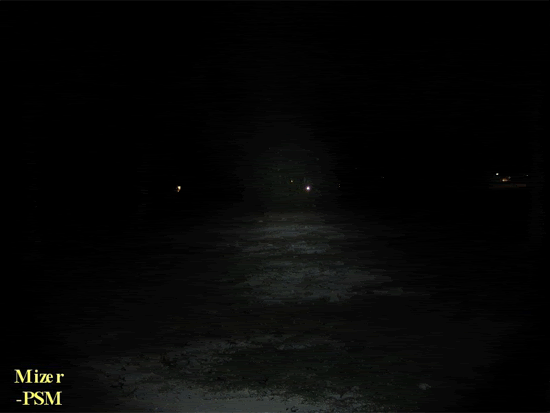
To close this FAQ … some final words of the builder:
"This light is first and foremost intended as a tool to be used and although the price is significant, it is not priced due to time and effort devoted to cosmetic perfection or appearance. There are cosmetic irregularities in the finishes and some parts have tooling marks. The quality of materials, fit and function are of import but the looks are secondary. Certain forms and mill work were chosen for their function with full awareness that a "fine" finish would not be an inherent result nor would it be possible without significant additional cost in labor and time."
Thanx for reading !
Buggs, McGizmo Marketing Department

Appendix - Wiz2x2 vs. NG2x2
The Wiz2x2 does have a low voltage shut off, somewhere in the Vin range of 2.2 - 2.5V. Consequently, there is an upper limit on drive current that can be maintained on a CR123 to keep the battery voltage from dropping, under load, below the shut off threshold. This upper limit is seemingly somewhere between 650 to 800 mA and wil vary as a function of Vf of the LED. Because of this, Wayne and I have agreed that the "stock" or standard configuration on the wiz2x2 should be at the 530 mA for high level. We have also found that 30 mA is ideal for a low level.
The Wiz2x2-530/30 is really quite optimal in terms of runtimes, light output via the 20 mm reflector and quite reasonable given thermal considerations. For a "good" package, I don't think there is any more optimal configuration.
Now about the NexGen2x2. With the fact that you always start out in low and then go to high (even if instantaneous), the NexGen2x2 does not go into safe mode. That is to say that it can be set with a 1 amp high and you will get 1 amp, even on a single CR123. The NexGen2x2 is quite capable of taxing the CR123 beyond its capacity. In a light the size of the PD, a 1amp drive level is hardly a good idea for any extended runtimes given thermal and battery considerations but it is possible. Obviously a NexGen2x2- 500 or 600 would make more sense in general terms and since the NexGen2x2 is marginally more efficient, why not just go with it?
There are two short comings with the NexGen2x2 and they are both due to the fact that it is a boost only circuit and have to do with the driver ending up in DD. If a R123 were used, The drive current would result in the nature of the specific LED since Vf would be above Vin. The real down side to the NexGen2x2 is in terms of the low level output. Again, depending on the Vf of the LED, the low level could not be set below say 90 to 150 mA because the circuit would go into DD somewhere in that range and not be effective in driving the LED at lower current levels. This is on a CR123. On a R123, there may be no controlled low level at all since Vin would be greater than Vf (low) until the battery was about depleted!
If someone wanted to go with a NexGen2x2, I would suggest a combo of say 900/200 where one basically did not have a "low" level but a economy level and "turbo" mode. Such a configuration might make sense for someone who needed max brightness as a defensive deterrent. For an EDC type light, I don't think this is a wise choice!!!
Appendix #2 on x2-drivers:
When Kilroy comes in contact with the piston which contains a functioning battery, a ground or (-) path is completed and the converter now has power. It will drive the LED at the low level dictated by the sense resistance circuit. When the contact ring is connected to ground (-), hopefully by making contact with the piston lip, the high level circuit is complete in the sense resistor package and the LED is in turn driven at the high level. If Kilroy is unable to make a ground connection apart from the contact ring being grounded as well, you will not have a low level of light.
The mechanics are rather simple, straight forward and exposed. Unfortunately the contacts themselves are also exposed and need be free and clear from metalic dust bunnies.
It is true of all of the "X2" family of drivers that the ground path as well as working current path is through Kilroy. Kilroy carries the load; not the big substantial contact ring. The contact ring is a high impedence signal contact and it doesn't take much contact with ground to signal for high level output. Very little current passes through the contact ring and a micro metal fiber can send the signal!
Appendix #3 on GDx2 driver:
It is a buck/ boost driver that should be a bit more efficient than the wiz2x2. It does have an interesting quirk in that on initial power up, it drives the LED at probably around 100 mA for a very short blast until it setles in on the current level of low set by the resistor. This means that there is a low power flash at the instant of turning on in low. The intensity and duration is not enough to adversely effect your night adaptation and it may actually aid in initial target acquisition. In the spirit of full disclosure, I bring this interesting quirk up.
The GDx2 has a low voltage drop off below that required of a non protected Li-Ion cell so the lights should only be planned as hosts to CR123 as well as protected R123 cells.
This thread is devoted to answer all your questions about the McLuxIII Series of McGizmo lights. It will be updated frequently as soon as new information is available, so make sure to check back often.
__________________________________________________
The McLuxIII-PD
__________________________________________________


What is the McLuxIII-PD
The McLuxIII-PD is the third generation of the McLux lights made by McGizmo. As opposed to the McLux-Aleph Series, this light is basically a stand-alone light without a modular approach. This means it isn't SF E-Series compatible, won't mix with Aleph parts and is ready to go when you receive it.
"PD" stands for "piston drive" and describes the new revolutionary mechanics of the switch incorporated in the light.
Please tell me more about the construction of the light!
Here's a pic showing the McLuxIII with various parts exposed:

… and here's the schematics:


The head is a return to the good old days of the first McLux lights and is an integral bulkhead design for optimum heat management. The LED rides directly on the metal of the head instead of using a threaded LE or other methods of interaction.

On the business end you are looking at a sapphire window that has AR-coating on the inside for optimum light-transmission and toughness. It is held in place by a new version of the bezel ring with a bigger lip for optimum impact protection as well as a further improved water seal at the front end. The front end of the PD is identical in thread and window seating to the Aleph 2 and one could use the Aleph 2 bezel ring instead of the one currently supplied. There is a reason for going with a ring that adds about .062" to the length of the light and that is strength. This bezel is significantly stiffer and stronger than the notched A-2 ring.
The battery tube is fairly straight forward and offers an attached Ti-clip as well as 2 small holes for lanyard attachment. Of course the switch is recessed to allow tailstand.
A true piece of art is the switching-mechanism … the piston-drive!
The piston is an electrically conductive sleeve that houses the battery riding on a contact spring. The environmental seal is achieved by an o-ring riding at the lower part of the piston making contact with the inner wall of the body. The piston is exposed at the rear end of the light (see pic above) and serves as momentary switch. The cool
There are two copper plated vias that go through the PCB and kilroy's legs go into these vias and are solder filled. Kilroy's nose is deflected about .030" in total as the lip of the piston first contacts kilroy for low level and then proceeds to bottom out on the perimeter contact ring for high output. This amount of deflection distributed over the length of kilroy seems to be well short of deformation. Since the beryllium copper is a material of choice in contact springs, we can only assume that there will be no issues of fatigue in this application. As to the integrity of kilroy's mount, I don't believe the solid footing through the PCB vias will be stressed by the load subjected to kilroy's nose in this application.
The full stroke of the piston is typically less than probably .060" (1.5 mm).

Note that there isn't any knurling on this light … yet it is still grippy to boot! The head has milled flutes to allow easy twist-operation and the body has grooves, the clip and the rear shroud for stability. No abrasion on your precious pants any more !
The o-ring dimensions are:
Piston : #016
Head : #017
Window : #019
What are the materials used?
Only the best for our customers :nana:
The light is CNC-machined from aircraft aluminium and TypeIII hard anodised in "dark slate grey", the color already familiar from the Aleph-Series. The clip is titanium, the window Sapphire Crystal with nice stress relieved and ground edges with AR-coating on the inside. For the piston we used brass with a nickel-plating for optimum conductivity. To ensure reliable and durable function, the kilroy is made of silver plated beryllium copper. The contact spring is also silver plated as well as the nickel plated brass contact. All wires are tinned copper and jacketed in tefflon. There is no aluminium anywhere in their path and both the head and sleeve of the McLuxIII-PD are completely anodized and outside of any electrical paths. Last but not least, the o-rings are EPDM.
What about the lens and possible replacements?
The lens is sapphire crystal with an internal AR coating ... extremely hard but sacrifices some output in the process. 4sevens has taken some "unofficial" measurements:
Lux at 1 meter:
1387 no lens
1229 (88.6%) stock sapphire AR inside
1222 (88.1%) stock sapphire AR outside
1371 (98.8%) water-white glass double side AR for arc4+ from flashtlightlens.com
The choice in this light is for maximum strength and durability of the lens with good light transmission, but there are other options. It is all a matter of choice between strength, transmission and possibly fragile outside coatings.
It seems that the lenses for the PD, Aleph2, Arc4 and HDE EDC are interchangeable ... and it seems that the PD's bezel ring will fit the other lights, too. But please be aware that you are on your own should you try anything foolish with those fine lights!
Which reflector does it use?
The light uses the venerable McR-20 which is well known of the Aleph-Series. More about this marvel can be read in the Aleph-FAQ in the same forum.
Basically you get three things with that reflector:
- the most perfect beam I have ever seen in a light
- a medium-flood type beam with a relatively big hotspot
- a very strong and concentrated corona that allows for a very useful low-mode

Here is an outdoor beamshot in comparison with some other well-known lights to show the beam characteristics of the McR-20 reflector. The pics are directly comparable due to fixed camera settings. Please note that those lights have different drive currents and aren't meant to compete with the McLuxIII here, this should be informative and allow you tro judge for yourself wether the McLuxIII suits your needs or not. It is not a competition.
McLuxIII-PD (UX1K)

SF KL3 gen2

SF L4

Fenix L1P

SF A2

What are the attachment options?
You have a Ti-clip and two lanyard-holes as well as a slim and small form-factor for easy holster-carry. The 15 mm "pico" clip will also attach to one of these holes and does not capsize.
There is now also the famous tab carry-option. With the McLuxIII-PD the tab is screwed on the clip whith the clip being still fully functional:

You must request that option when ordering.
The Tritium Option
Upon request Don can install a single tritium vial in the tail end of the light directly in the button of the piston:

Look at the left pic. Pricing is according to the "ordering thread" $25 and $10 for the clip mount.
The New Clip Option
Upon ordering you can specify that you'd like a new iteration of the Ti-Clip looking like this:

... instead of the standard clip. See the "Ordering" sticky for payment details.
Titanium Bezel Rings
As a limited offer Don created those ...

... that will also for your ALeph2, Aleph19, Arc4 and HDS EDC.
The McLuxIII-T
The McLuxIII-T is a titanium variant of the McLuxIII-PD:

It does not have a piston-drive activation and therefor a twist-only switch with the same 2-stage as the PD using a rev8 Wiz2x2. The LED is a TY0H driven at 525/20mA. It sports the upgraded bead-blasted clip and the new ti-bezel as well as ti-screws to attach the clip.
The TY0H is a "Joker" LED and coupled with the standard McR-20 you will get a more diffused beam with a stronger corona, bigger spot and less throw (=lux readings). It can be fitted with a McR-20J to accomodate the Joker LuxIII and get a standard MrR-20 beam if you are so inclined.
As opposed to the McLuxIII-PD the T uses a removable aluminium heatsink seated with Arctic Ceramic to allow an easy upgrade to newer LEDs:

This light is not compatible with the McLuxIII-PD, but the T-head will work on the PD-body, not vice versa.
No custom requests are accepted for this light.
The McLuxIII-Ti-PD
The McLuxIII-PD-Ti is basically a titanium version of the McLuxIII-PD and looks like this:

(picture taken by WAVE_PARTICLE)
Apart from the obvious little design alterations there are some differences worthy to be mentioned:
The Ti-PD uses the new GDx2 driver by dat2zip, a few words about this new driver can be read in Appendix #3 of this FAQ. It comes with the new clip, a titanium bezel and a tritium marker in the piston as well as titanium screws to hold the clip. The spring in the piston is a bit more recessed than in the standard PD to allow for a momentary activation that requires less force than before.
Just like the McLuxIII-T the LED is mounted on a removable aluminium heatsink for a better heat management and possible future upgrades of LED and driver.
The drive levels are about the same as those of the stadnard McLuxIII-PD. There was a list of possible bins to choose from upon order, so no standard LED configuration can be listed.
Can you show me a size-comparison?
Yepp, sure. Here is a pic comparing the McLuxIII-PD with some classics:

JIL rev1.3 // FireFlyI // McLuxIII-PD // Aleph2 1x123 // SF L4 with Standard Aleph Tailcap
And here's the McLux-Evolution:

McLuxIII-PD // McLux-Aleph2 1x123 with FT-Tailcap // McLux-TK
Yeah, nice … but how does it work?
This is the easiest part
The really good part is that in this light the head rotates and not the tailcap which means you can grab it with you hand and use your thumb and index finger to conveniently dial through the constant-on modes as opposed to the sometimes difficult one-handed action in previous lights. Coupled with the nice milled flutes at the head, the ease of use of this light is astonishing. You don't "need" a tactical grip, you can just hold it in your hand like your old Eveready flashlight of the Ages and turn instead of button-pressing. Just like in the old days …
The action of the piston is a smooth one, and the tension of the momentary-on is roughly the same as with the standard McE2S module of the Aleph-Series. If you are not familiar with this one … buy it, too
Please note that there isn't any lockout mode with this light.

You can unscrew the head further to ensure a highly unlikely accidental activation though. The non-soft spring together with the tail flare should take of the problem efficiently then.
Can the switch configured as "hair-trigger"?
You will find that you can "tweek" kilroy's nose to be as close to hair trigger or far (within reason) as you might like.
Please note that if you do mess with the kilroy spring and end up setting it below the plane of the contact ring such that kilroy does not contact the piston lip, the light will not light up!! If kilroy does not make contact, light won't come on! We have confidence that kilroy will last indefinitely given the displacement of the spring in regular use. It shall not be wise to be bending it back and forth to a great extent playing with adjustment constantly. Certainly time and abuse will tell....
Is it watertight?
Although not conceived as a dive-light, the McLuxIII-PD was able to withstand 120' in a pressure tank in a dive-shop without flooding
What's the configuration of the light?
The McLuxIII-PD sports a LuxeonIII-type LED driven by the new Wiz2x2 driver that allow for a regulated high and low mode. It uses a CR123 primary cell or any Li-Ion of similar size that does not exceed 6V. The high mode is set at 580mA and the low mode at 30mA.
Why 580/30mA?
Because after extensive beta-testing in our production plant it seems that those numbers are the best compromise between runtime, brightness, heat and actual usefulness. Yes, usefulness. This light is foremost a tool and thus isn't intended to be a pocket rocket of any kind to impress your mom. At 580mA it is plenty bright for virtually anything you'd want to do with a light this size and runs reasonably cool and long. At 30mA it is surprisingly bright for this little current-flow and boasts a most impressive runtime.
For those of you who always want more light at the expense of anything else :devil: … go for a custom configuration. But be warned
 that the actual usefulness might be diminished.
that the actual usefulness might be diminished.The drive current is set via sense resistors on the driver board. BTW, these resistors can be exchanged without any circuit disconect in a completed PD.
So … after all this talk … show me the runtimes!
Sure! Here you go:
The 500mA setting:

And an example of a 700mA drive level as well as the 30mA low-mode:

Li-Ions:
wptski got the following results:
MP123 cell stayed around 1580 lux for 1:15 than nosedived
AW LCR123, Lux and runtime the same but no pulsing like the MP123 cells
Please note that your individual runtime will depend on the Vf-bin of your specific Luxeon LED. It is also interesting to note that the runtime on the low-level is roughly doubled when compared to the resistored McE2S of the Aleph-Series.
What about that new Wiz2x2 driver?
This one is a new development of Wayne Yamaguchi (dat2zip) and is a buck/boost driver with a fully current regulated high and low mode. Input voltage is 2.5-6V and output voltage <6V. This means that you cannot use a LuxV :mecry:, but this also implies that it is perfectly ok to run the light with any Li-Ion that meets the size-criteria of a 123-cell.
As an additional bonus the driver has a cut-off voltage of 2.5V, so the use of unprotected Li-Ions is possible.
Because it is a buck/boost, the PD could host a red, R/O or Amber Luxeon as well and the set drive levels on the converter would be what the LED would get. Provided the target Vf of the LED does not exceed 6 volts, this driver will deliver!
As with the Wiz2 driver, this unit has a very high efficiency-rating and is certainly among the very best drivers nowadays in those regards.
For further discussion of this driver as well as the NG2x2 please have a look at the Sandwhich Shoppe and McGizmo forum as this would be too much for this FAQ.
Btw … this marvel is the first current regulated buck/boost that has regulated high AND low mode ever made to the best of our knowledge. Wayne … :thumbsup: :bow:
Note: upon depletion of your battery (approaching 2.5V) you might encounter "flickering" of the light. According to Wayne this is the "flatulent low battery indicator"
"The IC was designed for Li-ion batteries and as such will shutdown at a safe level. An fortunate/unfortunate effect is when the voltage is right at the shutoff voltage after shutting off, the battery recovers enough that it turns back on and then pulses driving the battery down again and the converter shuts down. "
To avoid questions about those yet-to-be-known drivers you can read a good statement by Don about the Wiz2x2 vs. the Ng2x2 in the appendix of this post.
Q: What about the tint of the low-mode?
The low-mode is current regulated which has a lot of advantages over PWM ... except tint. The tint of your LED will shift slightly to the warmer side of the spectrum ... meaning if you really cannot stand a warmer / slightly greenish tint you can significantly reduce the risk of such an issue in the low-mode by selecting a colder tint from the beginning.
Can I have a customised version?
Not right now, but in the near future Don will be open for custom orders following a certain yet-to-be-defined format within reasonable limits. This will most likely include variations of drive currents as well as the NGx2 driver. Stay tuned!
Please note that requests for special one-of-a-kind custom mods and jobs cannot be accomodated and will be turned down. We are sorry for this strict policy, but unfortunately Don hasn't succeeded in growing two additional arms yet :sick2: ...
Tritium custom jobs ... not now, sorry guys
Are there any other finishes or build-options? What isn't possible?
A McLuxIII-PD in HA-NAT has also been released with the bezel ring being black which means you can "instant anodise" dings resulting from drops with a sharpie pen. If you are lucky you might be able to snatch one of the elusive chrome over nickel PDs ...
You can request a bare aluminium light and your request will most likely be accomodated.
There are currently no plans for tritium vials in production lights and no plans for different battery tubes like 2xAA or twisty packs.
Also … forget about the LuxV :mecry:
For the time being, the Wiz2x2 shall be the only driver option, although there might be a NGx2 version on the horizon in the distant future.
What about maintenance?
As every tool, this light needs some maintenance. But not much. Just keep the o-rings lubed (especially when rough conditions or underwater-use are anticipated) and you're ok. If necessary you can disassamble the light and push out the piston via the top end of the body to clean your light. A dry o-ring on the piston might result in friction and resistance with the momentary switch. However, Don has used a prototype for 6 months now without any need to re-lube it.
Replacement parts can be ordered should the need arise. This might become true for the bezel ring after some heavy falls … and because of the construction of this part with the protruding lip it should take most of the hits and after replacement your light will look as good as new again.
How do I order one? And what does it cost?
Visit the McGizmo ordering&pricing sticky thread in this forum and follow the procedures there. It is that simple. The price of your light will depend on the LED being used.
Are there any kits offeres for DIY?
No. This is a turnkey light and comes fully operational to your door … assambled, lubed and with a battery.
Evolution of the McLuxIII-PD
After some time has passed Don implemented some minor improvements into the design:
"Lately I have been deforming (reforming) Kilroy's nose and shortening the battery spring to make the light smoother and easier to activate. These mods have been mentioned in the past but I have been taking the liberty to do them from the start. With the Krytox, stiction doesn't seem to increase over time so I am more comfortable with reducing the battery spring force. When I first started building the PD's I was using silicone grease and stiction was an issue. With a pug nose, Kilroy has more character and can't get his nose in the threads as easily."
You can do this yourself to improve your existing PD:
" In regards to the spring, I have found removing the small dead loop as well as about 1/2 revolution of live coil from the narrow end of the spring works well. You need two small pairs of pliers to bend the new tail down and away from contacting or trying to gauge the battery. If you find you have cut more spring off than you wanted to, you can stretch the spring and deform it to a longer length.
As to Kilroy, If you have an old or cheap set of needle nose or ring pliers, you can blunt or lop off the ends to the desired thickness at the tip and then make sure the jaw that is internal to Kilroy is radiused to allow for a reasonable movement towards the nose tip. You want to close the pliers with the outside jaw pushing kilroy's nose inwards and the inside jaw flairing his nose apart. Look at crude illustration below:

The black forms represent the cross sections of the pliers at the tips. As these are forced together I believe you can imagine the resulting reformation of Kilroy. Lop of the ends of the needle nose pliers until you get the desired cross section in the pliers tips. Do not cut off Kilroy's tip though."
New LEDs and drivers
In the advent of the new generation of power LEDs the McLuxIII-PD will use the Seoul P4 LED offering more light with less heat in a very similar beam pattern. The driver is the newer GDx2 driver.
With the now way brighter and more efficeint LEDs public demand created a "Mizer" option for the PD which has a high level current of 300mA instead of 525mA ... and increases runtime greatly while maintaining the brightness of the older U-bin LuxIII PDs (approximately).
Here's an animated gif illustrating the difference between the PD-S and PD-S Mizer ... done by PoliceScannerMan and animated by jch79, as usual. Thanx guys

To close this FAQ … some final words of the builder:
"This light is first and foremost intended as a tool to be used and although the price is significant, it is not priced due to time and effort devoted to cosmetic perfection or appearance. There are cosmetic irregularities in the finishes and some parts have tooling marks. The quality of materials, fit and function are of import but the looks are secondary. Certain forms and mill work were chosen for their function with full awareness that a "fine" finish would not be an inherent result nor would it be possible without significant additional cost in labor and time."
Thanx for reading !
Buggs, McGizmo Marketing Department

Appendix - Wiz2x2 vs. NG2x2
The Wiz2x2 does have a low voltage shut off, somewhere in the Vin range of 2.2 - 2.5V. Consequently, there is an upper limit on drive current that can be maintained on a CR123 to keep the battery voltage from dropping, under load, below the shut off threshold. This upper limit is seemingly somewhere between 650 to 800 mA and wil vary as a function of Vf of the LED. Because of this, Wayne and I have agreed that the "stock" or standard configuration on the wiz2x2 should be at the 530 mA for high level. We have also found that 30 mA is ideal for a low level.
The Wiz2x2-530/30 is really quite optimal in terms of runtimes, light output via the 20 mm reflector and quite reasonable given thermal considerations. For a "good" package, I don't think there is any more optimal configuration.
Now about the NexGen2x2. With the fact that you always start out in low and then go to high (even if instantaneous), the NexGen2x2 does not go into safe mode. That is to say that it can be set with a 1 amp high and you will get 1 amp, even on a single CR123. The NexGen2x2 is quite capable of taxing the CR123 beyond its capacity. In a light the size of the PD, a 1amp drive level is hardly a good idea for any extended runtimes given thermal and battery considerations but it is possible. Obviously a NexGen2x2- 500 or 600 would make more sense in general terms and since the NexGen2x2 is marginally more efficient, why not just go with it?
There are two short comings with the NexGen2x2 and they are both due to the fact that it is a boost only circuit and have to do with the driver ending up in DD. If a R123 were used, The drive current would result in the nature of the specific LED since Vf would be above Vin. The real down side to the NexGen2x2 is in terms of the low level output. Again, depending on the Vf of the LED, the low level could not be set below say 90 to 150 mA because the circuit would go into DD somewhere in that range and not be effective in driving the LED at lower current levels. This is on a CR123. On a R123, there may be no controlled low level at all since Vin would be greater than Vf (low) until the battery was about depleted!
If someone wanted to go with a NexGen2x2, I would suggest a combo of say 900/200 where one basically did not have a "low" level but a economy level and "turbo" mode. Such a configuration might make sense for someone who needed max brightness as a defensive deterrent. For an EDC type light, I don't think this is a wise choice!!!
Appendix #2 on x2-drivers:
When Kilroy comes in contact with the piston which contains a functioning battery, a ground or (-) path is completed and the converter now has power. It will drive the LED at the low level dictated by the sense resistance circuit. When the contact ring is connected to ground (-), hopefully by making contact with the piston lip, the high level circuit is complete in the sense resistor package and the LED is in turn driven at the high level. If Kilroy is unable to make a ground connection apart from the contact ring being grounded as well, you will not have a low level of light.
The mechanics are rather simple, straight forward and exposed. Unfortunately the contacts themselves are also exposed and need be free and clear from metalic dust bunnies.
It is true of all of the "X2" family of drivers that the ground path as well as working current path is through Kilroy. Kilroy carries the load; not the big substantial contact ring. The contact ring is a high impedence signal contact and it doesn't take much contact with ground to signal for high level output. Very little current passes through the contact ring and a micro metal fiber can send the signal!
Appendix #3 on GDx2 driver:
It is a buck/ boost driver that should be a bit more efficient than the wiz2x2. It does have an interesting quirk in that on initial power up, it drives the LED at probably around 100 mA for a very short blast until it setles in on the current level of low set by the resistor. This means that there is a low power flash at the instant of turning on in low. The intensity and duration is not enough to adversely effect your night adaptation and it may actually aid in initial target acquisition. In the spirit of full disclosure, I bring this interesting quirk up.
The GDx2 has a low voltage drop off below that required of a non protected Li-Ion cell so the lights should only be planned as hosts to CR123 as well as protected R123 cells.
Last edited:

